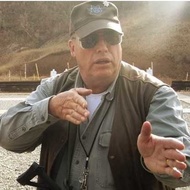9 May 20
“Comes the hour
Comes the man!”
Anon
In 1870, the “44 Russian” revolver cartridge set the pattern for all future revolver cartridges.
In 1870, Russian General Alexander Gorlov, assigned to the Russian Embassy in Washington DC, approached S&W and expressed interest in their single-action, top-break No 3 Revolver (“No 3″ indicated that this was S&W’s third frame size).
Gorlov’s interest eventually generated a sizable order, and S&W would ultimately sell 130k copies of its No 3 Revolver to the Russians, most being eventually manufactured under license at Russia’s own Tula Arsenal
Gorlov was also instrumental in bringing Gatling Gun technology, from America, into the Russian military!
The No 3 Revolver was very popular on the Continent, so much so that “reverse engineered” (and unauthorized) copies, mostly manufactured in Germany, showed-up all over Europe, well into the 1900s.
The No 3 Revolver predates Colt’s SA Army Revolver, because S&W owned Rollin White’s patent on bored-through cylinders, which meant S&W had a monopoly on bored-through cylinders (hence metallic cartridge revolvers) until the White Patent expired in 1871
But, there was a problem with the No 3!
It was originally chambered for the rimfire 44 Henry cartridge, later the nearly identical, but centerfire, “44 S&W American” cartridge.
Both featured a rebated, or “heeled” bullet. Bullets at the time were all lead, and thus soft. So, they had to be lubricated, or lead-build-up in the bore would render the pistol inaccurate and dangerous to use.
Accordingly, the case rim, and the bearing surface of bullet itself, are the same caliber, so the bullet had to be “rebated” at the rear in order for the back part to fit inside the case mouth. Lubrication grooves on the bullet’s bearing surface were, of course, necessarily forward of the case mouth, which meant that bullet lubrication (waxy grease) was exposed to the outside.
Gorlov found this arrangement unacceptable for a military service revolver, as the exposed tacky bullet lubrication would pick-up debris, making loading/reloading difficult.
Not wanting to lose this sizeable order, S&W engineers went right to work and redesigned the 44 S&WAmerican cartridge, so that the bullet diameter (and the revolver’s bore) was reduced from 44 caliber to 429 caliber, and the bullet thus no longer needed to be rebated, so the bullet’s entire bearing surface now fit inside the cartridge case.
So, lubrication grooves cast into the bullet, and the lubrication they contained, were now entirely on the inside of the cartridge case and not exposed to the outside.
Of course, a “step” had to be machined into the inside of the cylinder bores, so that the 44 caliber case mouth would come to rest on it, and the front of the bullet would then go on forward into the front part of the cylinder bore, which was now 429 caliber.
That solved the problem, and also set the pattern for all future revolver cartridges, as noted above!
This new cartridge was dubbed the “44 Russian,” (1870) and it was the parent of the American 45 Colt (1872), 38 S&W (1877), 32 S&W (1878), 32 S&W Long (1896), 38 Special (1898), 44 Special (1907), 357Mg (1934), 44Mg (1955), and 41Mg (1964), all still in production and active service today!
S&W’s No 3 Revolver was the Russian Army’s official sidearm from 1870-1895, when it was replaced by theBelgian-designed, double-action, 7-shot Nagant Revolver in 7.62x38R (7.62x54R “Short”).
The Nagant Revolver would see service with Russian (Soviet) army and police, through both World Wars. A few are still in-service today!
Today, the 44 Russian cartridge is considered obsolete and enjoys no following, save for a few Cowboy Action Shooters.
The 7.62x38R (AKA: 7.62 Nagant) is also obsolete and long-since out of production, at least in the West.
/John



